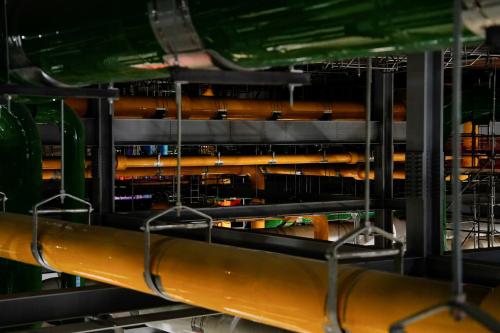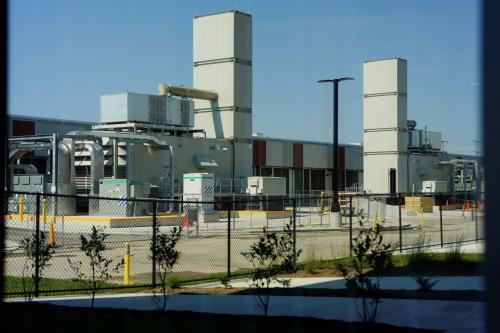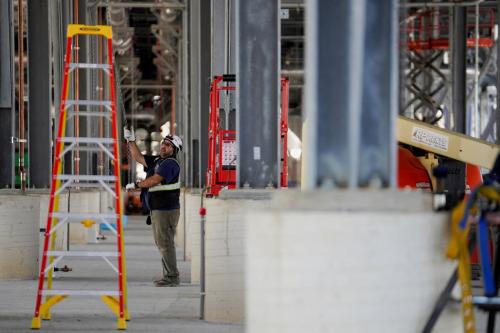The Central Valley is California’s agricultural heartland and a major contributor to the U.S. food supply. However, climate change, technological change, and stubborn inequality have threatened the region’s potential for inclusive growth. This case study examines how philanthropic leaders bridged public, private, higher education, and community interests and assets to attract and deliver $113.3 million in federal and state investment that positions the economy for future growth. Key takeaways for regional civic and philanthropic leaders include:
- Regional civic collaborations designed to solve one economic problem or seize an economic opportunity can provide flexible capacity to respond to future problems and opportunities—particularly when done in a thoughtful and deliberate manner that builds credibility and trust across sectors and communities.
- To achieve civic collaboration involving many institutions, public and private funders must also invest in civic integration: a set of capabilities that support coalition governance, facilitation, community engagement, and shared evaluation. These functions are essential to reducing redundancy and ensuring coordination across projects and initiatives. While often overlooked, their cost is modest relative to the value they add by maximizing the impact of programmatic investments.
- Funders can play a critical role in shifting the narrative from zero-sum competition to collective opportunity. While resource constraints are real (and likely to grow as federal support for local initiatives recedes), many nonprofits have become accustomed to competing over limited grants instead of collaborating to attract new public or private investment. Philanthropic leaders are uniquely positioned to change this dynamic by modeling collaboration, emphasizing shared benefits, designing grant programs that build complementary capacities across organizations, and fundraising on behalf of their partners.
The case study series
Between 2021 and 2022, the federal government passed major legislation authorizing nearly $4 trillion in economic investment, including $80 billion in place-based industrial policy. Brookings has been tracking these investments, including the early implementation of coalition-based grants aimed at advancing key national priorities such as national security and economic and technological competitiveness.
This case study is part of a report series that goes beyond the programmatic efforts catalyzed by these investments to examine the underlying civic infrastructure that regions have begun to build—and will ultimately need to sustain in the long term—to support resilient, inclusive, and innovation-driven economies.
The main report details five functions that regions need, with a particular focus on the unique role of local philanthropy in supporting these functions, both as funders and strategic partners. The five functions are:
- Connect networks and build trust among increasingly disconnected economic actors, including business leaders, community organizations, students, and entrepreneurs.
- Orient regional stakeholders toward a shared understanding of the economy and the pathways to inclusive growth.
- Activate key business leaders to inform, engage, and invest in strategic regional inclusive growth efforts.
- Integrate teams of diverse, complementary organizations to solve specific, high-priority challenges using evidence-based interventions.
- Mobilize resources through sustainable financial models to maintain momentum, using performance measurement tools to identify the highest-priority areas for investment.
The five case studies—Chicago/Illinois; Fresno, Calif.; New Orleans; Syracuse, N.Y.; and Tulsa, Okla.—illustrate how these functions and the philanthropic leadership that enables them play out on the ground. Each region has received different forms of federal funding under the 117th Congress, and also varies in size, geography, and maturity of economic and workforce development ecosystems—thus offering lessons for a range of philanthropic and civic leaders across the country.
Background
The San Joaquin Valley, centered around Fresno, Calif., is known as a “produce basket” region. The agriculture sector there specializes in fruits, vegetables, and nuts, and accounts for 14% of the region’s gross domestic product, 17% of its jobs, and 19% of its revenue. However, despite strong demand for the region’s products, relatively low productivity in the sector and other structural challenges have limited inclusive growth. The region’s unemployment rate has consistently been about double the national average, and child poverty exceeds 30%.
Fresno faces a stark contradiction: Despite its agricultural abundance, nearly 45% of workers in the region struggle with food insecurity. (This section is informed by prior Brookings research on the Build Back Better Regional Challenge.)
In recent years, the region has faced converging economic pressures. Climate change is threatening the conditions that have allowed the agriculture industry to thrive. The Central Valley is one of the most water-stressed regions in the United States, and efforts to improve environmental sustainability could have a significant impact on the sector. By one estimate, California’s Sustainable Groundwater Management Act (SGMA) could reduce available agricultural land in the area by up to 900,000 acres and eliminate 50,000 jobs by 2040.
At the same time, the industry is ripe for automation, which would drive productivity, but has the potential to threaten as many as half of the region’s agricultural jobs in the next two decades. Workers’ concerns about automation and labor market disruption are warranted, as they have seen new technologies erode the demand for workers over decades. Longtime residents might remember the introduction of the mechanical tomato harvester in the mid-1950s, which displaced 82% of tomato growers and 32,000 farmworker jobs in just five years.
This left the region with a core challenge: how to ensure that technological advances drive productivity and support the competitiveness of the region’s core industry, while mitigating displacement of local farmworkers.
How civic and philanthropic leaders are mobilizing federal resources
The Central Valley Community Foundation (CVCF)—based in Fresno and serving the six-county region of Fresno, Madera, Tulare, Kings, Merced, and Mariposa counties—embraced an active role in driving economic development and inclusion in the Valley. CVCF intentionally connected and convened a diverse group of stakeholders to review the region’s flagging economic trajectory and the impact it was having on marginalized communities, seeking to share information and build trust. This collaboration provided foundational leadership in the creation of Fresno DRIVE (Developing the Region’s Inclusive and Vibrant Economy) in 2020, which brought together civic, business, higher education, and community leaders and networks to shape strategy and activate almost $4 billion in public and private investment in economic, community, and workforce development. Fresno DRIVE leveraged cross-sector partnerships, pulling together a 300-person steering committee and a 38-member executive committee, and has raised over $600 million in philanthropic and public support since it launched.
Fresno DRIVE prepared the region for an unexpected opportunity when the Economic Development Administration (EDA) launched the $1 billion Build Back Better Regional Challenge (BBBRC) in 2021 as part of the American Rescue Plan Act (ARPA). The BBBRC was a national competition designed to promote regional industrial growth and support equitable economic recovery from the COVID-19 pandemic. Leaders at CVCF identified the BBBRC as a critical opportunity for strategy and investment, and presented it to the Fresno DRIVE Steering Committee, which saw it as a chance to secure significant federal investment to address the region’s long-standing challenges.
The result was the Fresno-Merced Farms Food Future (F3) Coalition, which emerged out of Fresno DRIVE, and, with CVCF’s stewardship, managed to unite a region with deep fissures between communities, sectors, and institutions behind a shared vision for advancing ag-tech. The F3 Coalition included the views and perspectives of farmworkers, environmentalists, industry, and the region’s colleges and universities, which formed the basis of the F3 Initiative, the region’s BBBRC application.
The EDA rewarded the F3 proposal’s ambition and collaboration, awarding it $65.1 million—the largest investment in the national competition. The F3 Coalition distributed EDA funding across five key innovation and workforce development initiatives, each with their own network of implementing partners. Importantly, the coalition reserved $2 million for “Partner Integration and Collective Impact,” resourcing CVCF to reinforce the common agenda and provide governance, communication, community engagement, and a shared measurement system across all F3 projects.
This award was notable nationally and regionally for several reasons. First, the region lacks a history of cross-sector collaboration, so efforts to convene stakeholders required building new collaborative muscles and fostering a trusting attitude focused on collective goals rather than individual organizational interests. Second, the region has long struggled to engage industry in collaborative efforts. While this remains a work in progress, the BBBRC award and subsequent work represent a meaningful step toward greater industry participation. Finally, being the convener and catalyst of an economy-shaping investment is a novel role for a community foundation in most regions. This is underscored by the fact that CVCF was the only philanthropy or community foundation to be the lead organization among BBBRC grantees.
How civic leaders leveraged a strong philanthropic platform to build the trust required to drive mutually beneficial impact at scale
CVCF recognized that it was uniquely positioned as a convener of the BBBRC effort, given its demonstrated success both setting a vision for the economy as well as its track record as a neutral (though not passive) stakeholder that could actively mediate conflict (as in the case of workers and industry) and competition (as in the case of higher education institutions) among key partners. CVCF adopted a “collective impact” approach, which posits that complex societal issues require cooperative, cross-sector solutions. The five conditions of collective impact are: 1) a backbone organization (CVCF); 2) a common agenda across partners (to advance the region’s ag-tech industry cluster); 3) mutually reinforcing activities; 4) communication; and 5) shared measurement. Keeping everyone aligned while developing the concept was a key challenge. Reflecting on this period, one CVCF staff member noted that when bringing government, community, and private sector actors together, “everybody moves at a different speed…and with a different sense of urgency.”
CVCF also brought a mindset shift to coalition partners who were used to thinking of community investment as a zero-sum game. Without strong advanced industry leadership or an R1 research university (a national designation for institutions that attract significant federal funding and conduct substantial research activity), the region has often been overlooked for outside public or private investment, instead competing over limited local funds. Leaders in the coalition started to develop “a new muscle of collaboration” based on the belief that robust collaboration could bring new resources to the region.
But all of the region’s thoughtful preparation could only go so far to prepare it for the task of successfully driving $65.1 million of investment that would ultimately be dispersed and re-granted among many partners in an effort aimed at crossing silos. To do so, CVCF took on the role of integrator, creating a governance and collaboration framework that placed organizations into areas of strength. CVCF President and CEO Ashley Swearengin explained the organization’s approach to building collaborative civic capacity: “What we do at the CVCF is pay attention to where people are walking, and then we pour the concrete to the sidewalk. For example, if there’s a lot of natural leadership being exhibited by this particular community college in one area, we asked: ‘Would you be the lead on this?’ Because it was already their domain, their colleagues would be less likely to be mad about it. So, we acted as a ‘collaboration whisperer’ by nudging these organizations into key roles.”
Successful integration requires not only understanding the existing and potential complementary capabilities of partner organizations, but facilitating productive relationships as well. CVCF has been working to build trust among partners without a track record of collaboration. This was particularly important, for example, for smaller organizations that have a history of mistrust and competition with larger entities such as universities when it comes to funding. While CVCF strategically selected larger, more administratively capable institutions (such as University of California Agriculture and Natural Resources, University of California Merced, and Merced College) as fiscal sponsors for key initiative functions, they mediated conversations around resource allocation transparently—reassuring smaller service providers and community-based organizations that their role and value were recognized and essential despite working under a larger institution’s administrative umbrella.
And while capacity building is often aimed at small and under-resourced organizations, CVCF focused some of its efforts on helping more established organizations such as its community college partners develop the new fiscal functions, re-granting mechanisms, and collective impact coordination required for collaboration at this scale. This had downstream impacts on smaller organizations: Federal funding came in the form of “reimbursement grants,” for example, which required organizations to “float” the costs they incurred delivering on grant activities until they were paid back. This was much easier for well-resourced entities to do than smaller, community-based organizations.
The evolving role of philanthropy for the future of an inclusive ag-tech-driven economy in the Central Valley
As CVCF and its partners look beyond the BBBRC grant to continue the regional economic transformation catalyzed in part through federal funding, they recognize the importance of shifting away from a grant-dependent approach to mobilize capital with diversified, sustainable financial models.
Central to its collective-impact orientation, CVCF has taken seriously the role of ensuring shared measurement and evaluation, establishing a dedicated team and systems (Salesforce and quarterly dashboards) to ensure transparency, accountability, and the ability to quickly adapt strategies. Rigorous measurement and evaluation were critical not only to transparency, but also for preventing conflict among partners by creating common reference points for success and demonstrating the effort’s impact potential to potential investors.
CVCF and its partners also recognized that an independent nonprofit entity, F3 Innovate (formerly iCREATE), was needed to ensure ongoing collaboration among key anchor institutions—including state agencies—beyond the life of the BBBRC grant. This new organization is supporting academic and government leaders to regularly engage industry leaders in support of climate-smart food and agriculture, providing a flexible and nimble partner to support industry research and technology commercialization. It is developing initiatives to organize the region’s research and development assets and make them more accessible and visible to entrepreneurs, investors, and industry; develop regional partnerships to foster international trade; run innovation grant and investment programs; and serve as the convener and organizer of the region’s ag-tech ecosystem.
F3 Innovate ensures that an organization is waking up every day thinking about the Central Valley’s future position in its most important industry. Sustained resources are a major focus. California provided $32 million seed funding for F3 Innovate, and the state has looked to the F3 Initiative as a model for regional economic development that could be implemented statewide through its Jobs First Economic Blueprint. But F3 Innovate is also considering other revenue streams, including fee-for-service programs, conference revenue, and membership revenue to help sustain the organization’s operations.
Regional leaders are also positioning this work for the private sector to provide a complementary source of capital, with the potential to expand or sustain the agrifood tech cluster beyond federal and state grants. This requires attracting deeper industry investment into regional initiatives, particularly those focused on emerging technologies in agriculture, climate adaptation, and sustainable farming practices. Moreover, expanding employer-led workforce training programs is essential to ensuring that the benefits of these investments are broadly shared. Long-term private sector engagement goes beyond financial contributions: It requires companies to engage as true partners, be transparent about changing needs, and help incumbent workers adapt and advance.
This integrated approach of blending philanthropic, public, and private capital can provide the necessary financial stability to maintain momentum beyond the current federal funding cycle. CVCF has substantially improved the “investment readiness” of the Central Valley by convening diverse stakeholders, aligning strategic interests, and facilitating robust collaborations between the public, private, and philanthropic sectors. “Having laid this foundation, the region is prepared to translate public investment into economic growth and resilience,” CVCF’s Director of Impact Christy Patch explained, “benefiting local residents and businesses, and the country as a whole with a more sustainable food supply and climate-positive outcomes.”
Key takeaways for civic and philanthropic leaders
One lesson this case study illustrates is that collaborative capacity—when built in support of a rigorous understanding of economic assets and challenges, and with intention to meet them—can be sustained and leveraged as conditions change and future needs and opportunities emerge. Trust, credibility, and alignment across sectors and communities form the basis of durable platforms for navigating future economic disruptions and the sustained, iterative work required for economic transformation and growth. The work required to get there is often slow and difficult, but that is all the more reason that it can’t be scaled up and down quickly as conditions change.
A second takeaway is that public and philanthropic funders should not treat integration and mobilization as peripheral functions. These are the mechanisms that allow programs to add up to more than the sum of their parts, and be sustained over time—and the cost of doing them well is modest relative to the value they unlock. While often overlooked in favor of more visible programmatic investments, these connective functions reduce redundancy, build alignment, and allow communities to act with greater precision and accountability. Resourcing this work appropriately—both with dollars and authority—is essential for regions that want to move from episodic coordination to true system-building.
Finally, funders can help create the conditions for organizations to see collaboration as a strategy for growth, not as a threat to survival. In many places, the public and nonprofit sectors have been conditioned to compete over limited local philanthropic resources rather than collaborate to bring in new public and private funds. Philanthropies are uniquely positioned to change this dynamic by modeling collaboration, funding complementary capabilities across institutions, and fundraising to mobilize new investments. Doing so requires moving beyond a program- and initiative-oriented mindset, and toward one that treats civic infrastructure as central to regional economic transformation and inclusive growth.
Case study series





The Brookings Institution is committed to quality, independence, and impact.
We are supported by a diverse array of funders. In line with our values and policies, each Brookings publication represents the sole views of its author(s).




